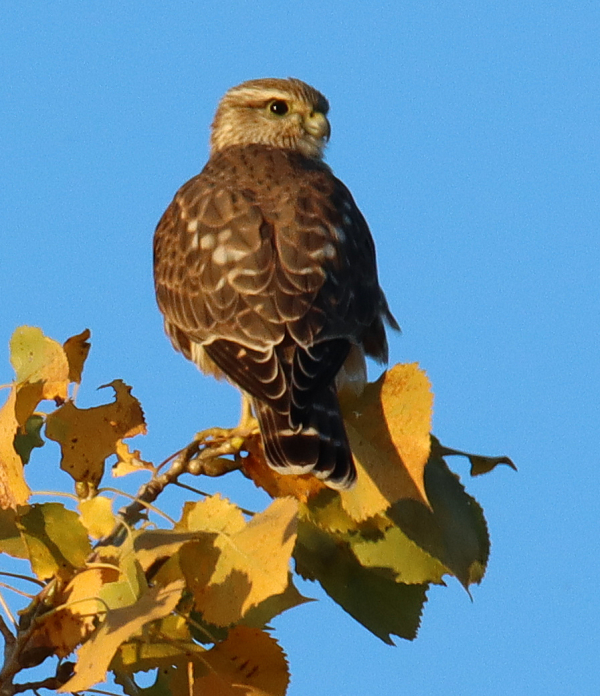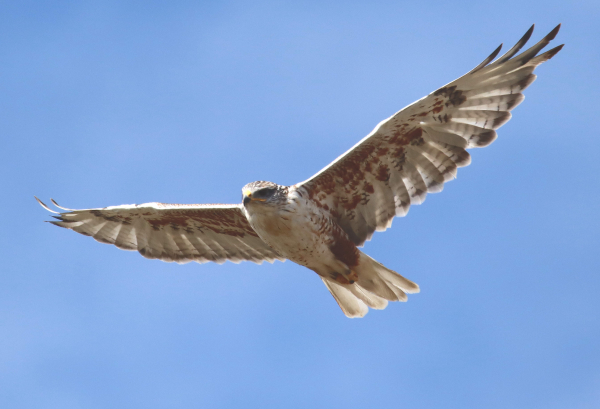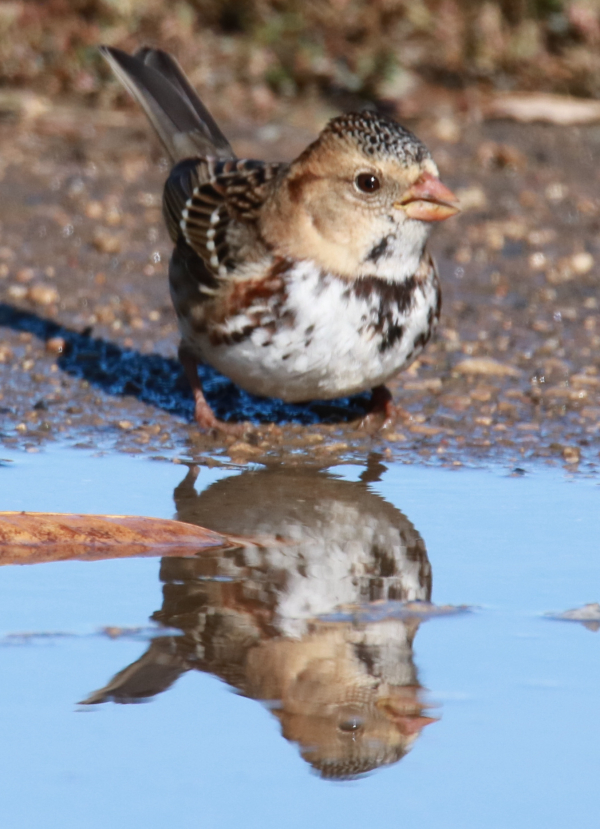
The third falcon of Monday’s afternoon drive, a Merlin perched on the highest branch of a nearby fall-colored cottonwood tree.

Another surprise raptor, an adult Ferruginous Hawk, provided extended hunting observations and photo ops last Thursday.

During the Ferruginous Hawk observations, midday sunlighting created shadows that deemed the photos more documentary in quality, although the backlighting in the above image records the big raptor’s spectacular wingspread.

The first of fall Harris’s Sparrows arrived Sunday and Monday in Dakotaland, a regular stopover area for the species.
|
A local 3 falcon afternoon must have been payoff for the intense winds that put a damper on birding over the weekend. After sighting a Prairie Falcon on the Lost Road, just 200 yards from the Prairie Falcon I sighted 15 days earlier, I considered my Monday birding drive complete after finding such a rare and iconic bird as I left it perched on a tall prairie hilltop surrounded by seemingly unbroken buffalo prairie. But less than a mile south of my office, the third falcon materialized – a magic Merlin was perched on fall-colored yellow cottonwood leaves – and I managed some photos!
The first falcon of the afternoon was a male American Kestrel that took flight over the rugged prairie hills on the eastern escarpment of the Missouri Coteau, about 2 miles before (south of) the Prairie Falcon. Initially I thought the kestrel might be a Merlin, but upon seeing its rufous and gray coloration as it sliced the blue sky it revealed its true identity. The variety of raptors I encountered was exciting with an adult Bald Eagle and a male Northern Harrier adding to the Buteo count of 8 Red-tailed Hawks and 3 Swainson’s Hawks.
The female rufous morph Swainson’s Hawk was 1 of the 3 Swainson’s observed, which made me happy she had not initiated her migration during the weekend’s strong north wind, but seeing her also made me wonder about her mate and 3 fledglings. Other species in the area that seemed to be poised for migration were flocks of Western Meadowlarks, Mourning Doves, and Killdeers. I was glad to see a Belted Kingfisher that provided some photos from a bit more of a distance than I would have liked, but a few feet down the road a flock of about a dozen sparrows fired me up as they foraged for seeds in an opening – migrating Harris’s Sparrows! After seeing my first Harris’s Sparrow the evening before at home outside my bay windows, it was nice to see they are becoming a part of the local migrants.
Thursday’s Capitol Run
Although I found 3 falcons Monday, I was initially alert for a big falcon flight while driving west to the Missouri River, then north to Bismarck last Thursday. I knew it was near the peak time for falcon migration, but it was actually a big white and orange hawk that made my drive most interesting. About 17 miles west of home, a flash of white wings and tail at ground level alerted my attention to an impressive adult Ferruginous Hawk. I passed the bird, reversed my direction and parked safely to await its next move as it stood on the ground temporarily. I was thrilled when the hawk flew low almost directly toward me, providing a few different photo angles as it winged to the road and veered west, flying low over a colony of Richardson’s Ground Squirrels – obviously on the hunt.
It landed a second time; I repositioned, and for a second time the hawk flew low in my direction, eventually doing some hang time in front and above me to the delight of my camera. I hadn’t seen a Ferrug for about a month, and while this adult might have been a local nester, it may have been headed south from southern Saskatchewan or points in between. Named for the shade of orange coloring the feathers that cover its legs, spot its underside, and mix with brown and white plumage on its back. I could see from the resulting photos that this male is at the end of its summer molt, with the outer primaries, central tail feathers, and many wing coverts still growing in. It was an impressive bird nonetheless.
Other birds of prey along the way included 14 Swainson’s Hawks, 12 Red-tailed Hawks, a rare migrating Sharp-shinned Hawk, and 2 falcons, an American Kestrel and a dark-brown Merlin that flew into view as I was pulled over to check out a pair of Swainson’s Hawks that included a dark morph individual. The Merlin materialized below a rugged prairie hill, flying in my direction, requiring me to grab my camera when I realized the mini-falcon was getting ever-closer to my windshield. I tried to focus on it as it winged forward and tipped toward my driver’s side window, and zip – it was gone. The last 4 Swainson’s Hawks provided an interesting observation near Bismarck as they foraged on the ground in a green meadow of short grass as a family group – an adult pair with their 2 fledglings, possibly feeding on large insects, a behavior Swainson’s often adopt during fall.
Home Migrants
BirdCast predicted a “High” migration overnight last Tuesday-Wednesday, which must have created a few sightings of my first Yellow-rumped Warblers of fall migration, small active groups of 3 or 4 in basic plumage foraging momentarily outside my bay windows every couple of hours. But they didn’t hang out long, apparently leaving the next night when another “High” migration period was predicted. Other yard birds included a visit from a calling Northern Flicker Wednesday, and Thursday a Mourning Dove perched adjacent to my feeding station for an extended period. (Dove visits are surprisingly rare in my yard considering Mourning Doves are common in the area).
Saturday morning’s northwest wind brought a new fall species to my yard – Ruby-crowned Kinglets! I guess I forgot how small they are, and it was fun to see single birds and groups of 2 and 3 during their rapid search for small insects and spiders in low tree branches. That’s also when the first White-breasted Nuthatch fed at my suet feeder – hooray!
Another new suet diner appeared Sunday, a young male Downy Woodpecker, and a couple Yellow-rumped Warblers foraged in my ash trees, likely new migrants. As the sun was setting, another new bird perched outside my bay windows, a favorite fall and spring migrant, a Harris’s Sparrow. After perching a minute on the adjacent elm tree, it dropped down to my bird bath to drink and stand for a minute before moving onward. Harris’s Sparrows are one of my local indicators that fall migration is in full swing, and after leaving their nesting range along a belt where the northern forest meets the tundra, some will stay here for a while to forage on the ground for seeds in native sparrow fashion.
Weekend Wind
After a rainy Friday, the weekend offered some sunshine, but the wind was intense, keeping most birds under cover or sending them south with the wind at their back. I still took abbreviated drives to check on birding opportunities, to the south Saturday and north Sunday, but most birds were in hiding. That 2-sentence report brings us full circle, because Monday’s 3 falcon outing was described at the beginning of this article. With the swings of weather and sunlight, and the activities of migrating birds, these days of fall provide a level of special attention and excitement that ties our birding interests with the broad umbrella of nature as we enjoy searching habitats ranging from woodlands to prairies, wetlands to backyards and parks for interesting birds among fall colors. Enjoy your week ahead with some opportunities to get absorbed in the birds and nature around you.
Article and photos by Paul Konrad
Share your bird sightings and photographs at editorstbw2@gmail.com